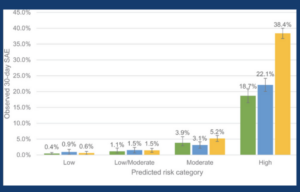Kaiser Permanente researchers develop risk calculator to guide hospital admissions from the emergency department
A new risk calculator could help emergency department physicians determine which patients with acute heart failure should be hospitalized and which can safely be discharged and return home, new Kaiser Permanente research suggests.

“Historically, there have been very high admission rates for patients with acute heart failure from the emergency department,” said the study’s lead author Dana R. Sax, MD, MPH, an adjunct investigator with the Kaiser Permanente Division of Research and an emergency medicine physician with The Permanente Medical Group. “These are complicated patients who usually have other chronic health problems that can become worse during an episode of acute heart failure, which makes it difficult to determine who can safely return home. We developed the risk calculator to help guide this decision making.”
Heart failure occurs when the heart isn’t able to pump as much blood as the body needs. The condition, which can get continually worse over time, can cause damage to the kidneys and other organs and lead to fluid buildup in the lungs. Acute heart failure occurs when a person suddenly starts to have new or worsening signs or symptoms of heart failure, such as shortness of breath, weakness, fatigue, an irregular or fast heartbeat, or coughing and wheezing — leading many to seek care in the emergency department.

The risk calculator assesses a patient’s 30-day risk of experiencing a life-threatening medical event based on their age, sex, race, ethnicity, and other sociodemographic factors; prior visit history; how they arrived at the emergency department; test results; and need for ventilator support. Using this information, the calculator places a patient into 1 of 4 risk categories: low, low/moderate, moderate, or high. Low and low/moderate risk patients whose symptoms are improving and have a safe discharge plan can be considered for discharge from the emergency department, while higher-risk patients may benefit from hospital admission.
The retrospective study, published in JACEP Open, included all 26,189 patients who had been treated in a Kaiser Permanente Northern California emergency department for acute heart failure between January 2017 and December 2018. First, the research team used its 30-day risk calculator to assess each patient’s risk of experiencing a life-threatening event, requiring an immediate medical procedure, or dying from heart failure. Patients were categorized into 1 of the 4 risk categories based on their predicted risk. Then the research team assessed the patients’ 30-day mortality rates by risk category and by whether they were admitted to the hospital, discharged home, or discharged home after observation.
When applied to the 26,189 patients studied, the calculator put 51% of the patients into the high-risk group. For these patients, the 30-day mortality rate ranged from 13% to 20%, with the highest mortality rate experienced by admitted patients.

The calculator put 25% of patients in the low or low/moderate risk groups. For these patients, the observed 30-day mortality rate was less than 1%, regardless of whether patients were discharged, observed, or admitted to the hospital. This suggests hospitalization may not offer a survival benefit for these low-risk patients. For the 23% of patients the calculator determined were in the moderate-risk group, the 30-day mortality rate was 2%.
“There have been other attempts to stratify patients into low and high risk groups, but they have not been as successful,” said the study’s senior author Mary Reed, DrPH, a research scientist at the Kaiser Permanente Division of Research. “We think the results from this study show the risk calculator we developed weighs a group of factors that can be difficult for a physician to quickly assess when they are trying to decide whether to admit a patient in the emergency department with heart failure.”
The next step, the researchers said, is to prospectively study use of the risk assessment tool in real-time clinical practice in the emergency department. “We are ready to implement the tool as a pilot project,” said Reed. “Then, if it is effective, we will aim to spread its use more broadly.”
The study was funded by The Permanente Medical Group’s Delivery Science and Applied Research Program.
Co-authors include Dustin G. Mark, MD, and Jamal S. Rana, MD, MPH of the Division of Research and The Permanente Medical Group; Sean P Collins, MD, of Vanderbilt University; and Jie Huang PhD, of the Division of Research.
# # #
About the Kaiser Permanente Division of Research
The Kaiser Permanente Division of Research conducts, publishes and disseminates epidemiologic and health services research to improve the health and medical care of Kaiser Permanente members and society at large. It seeks to understand the determinants of illness and well-being, and to improve the quality and cost-effectiveness of health care. Currently, DOR’s 600-plus staff is working on more than 450 epidemiological and health services research projects. For more information, visit divisionofresearch.kaiserpermanente.org or follow us @KPDOR.





Comments (0)